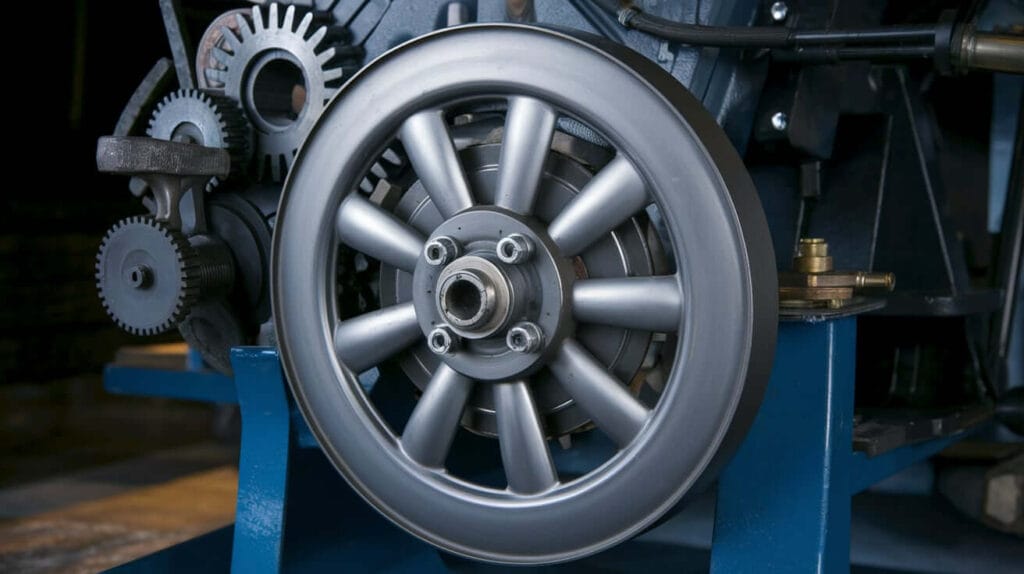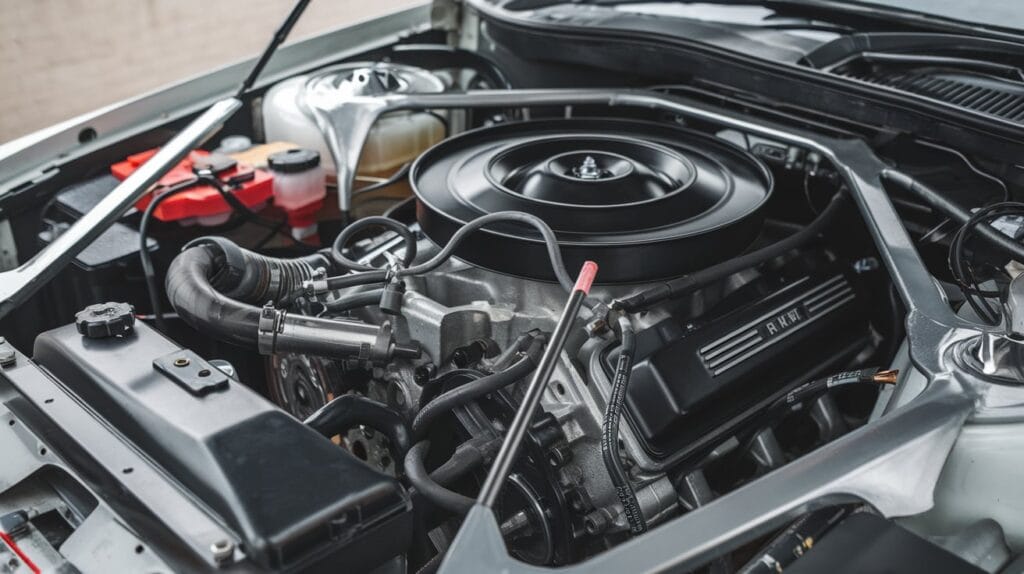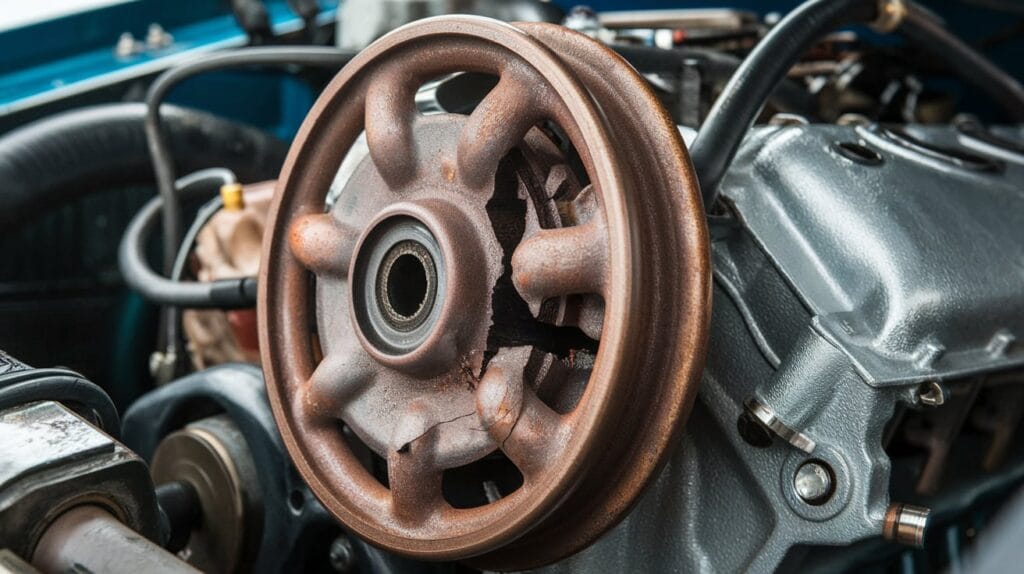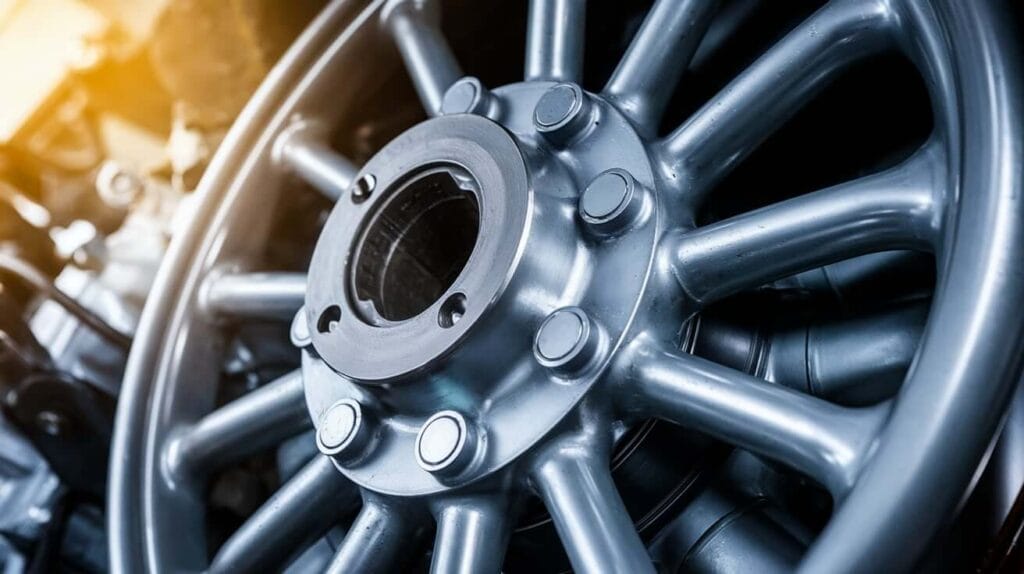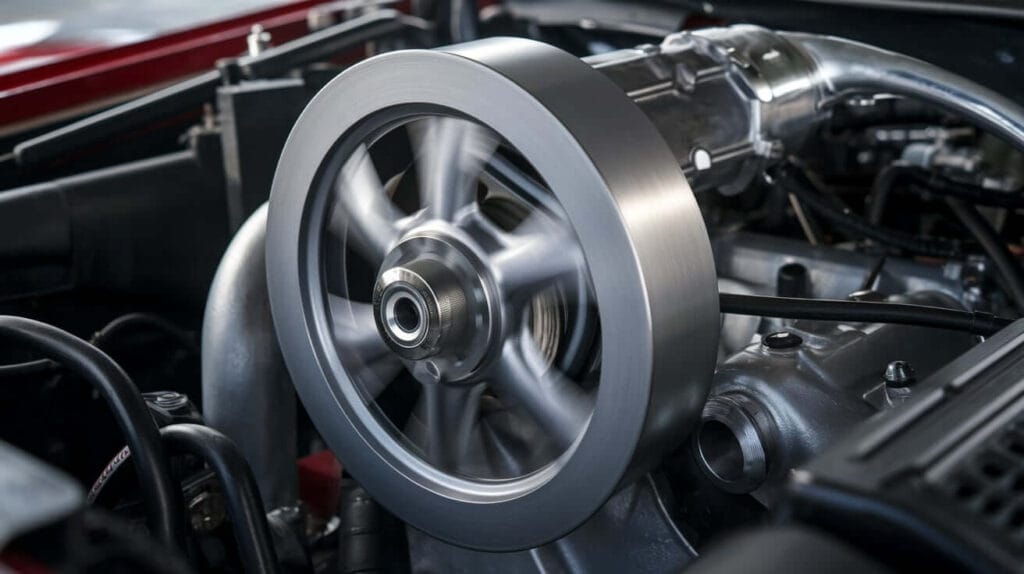Is your vehicle showing signs of trouble? Knowing how to tell if your flywheel is bad can save you from costly repairs. Look out for symptoms of a bad flywheel like unusual noises, gear slipping, or vibrations. Learn what causes flywheel damage and how to spot issues in automatic transmissions. Ignoring these signs can lead to severe drivetrain problems. Stay informed and keep your vehicle running smoothly!
What is a Flywheel?
A flywheel is a round, heavy metal disk that helps your car’s engine work smoothly. It stores energy from the engine and keeps it balanced, making sure the engine runs steadily without sudden stops or jerks. In manual cars, the flywheel connects the engine to the clutch, helping transfer power to the transmission. In automatic cars, a similar part called a flexplate does the same job. The flywheel also plays a key role in starting the engine, as the starter motor uses it to crank the engine when you turn the key. Simply put, the flywheel helps your engine run smoothly and keeps everything working in sync.
Difference Between Flywheel & Flexplate
A flywheel and a flexplate are both parts of a car’s drivetrain, but they serve slightly different purposes depending on the type of transmission. A flywheel is used in manual cars. It’s a heavy, solid metal disk that connects the engine to the clutch, stores energy, and helps keep the engine running smoothly. It also has a surface that the clutch presses against to transfer power to the transmission.
A flexplate, on the other hand, is used in automatic cars. It’s thinner and lighter than a flywheel and connects the engine to the torque converter instead of a clutch. The flexplate still helps transfer power, but its main role is to ensure the engine and transmission work together in an automatic system.
The main difference is that flywheels are designed for manual transmissions, while flexplates are made for automatic transmissions. Both are essential for their respective systems to function properly.
Symptoms of a Bad Flywheel
The flywheel in your car plays a key role in keeping the engine and transmission running smoothly. When it starts to fail, your vehicle may show several signs that shouldn’t be ignored. Recognizing these symptoms of a bad flywheel early can save you from bigger, more expensive problems down the road.
Here are the common signs of a failing flywheel:
- Unusual noises:
- You might hear grinding, rattling or scraping sounds when starting the car or shifting gears. These noises often come from damaged flywheel teeth.
- Vibrations:
- Excessive shaking or vibrations, especially when accelerating or shifting, can indicate a warped or damaged flywheel, similar to issues covered in our guide on What Are the Most 6 Common Steering Problems in Dubai? where vibrations often point to deeper mechanical faults.
- Slipping gears:
- The transmission may struggle to stay in gear or slip into neutral unexpectedly, a sign that the flywheel isn’t transferring power properly.
- Difficulty starting the engine:
- A worn-out flywheel can prevent the starter motor from engaging correctly, causing problems when trying to start the car.
- Clutch issues:
- In manual cars, you may notice the clutch slipping, sticking or feeling spongy, which can point to flywheel problems.
- Burning smell:
- A hot, burnt odor, especially when driving uphill or in stop-and-go traffic, could mean the flywheel is overheating.
- Poor acceleration:
- A damaged flywheel can reduce power transfer, making it harder to pick up speed smoothly.
If you notice any of these signs of a bad flywheel, it’s crucial to address the issue quickly. Ignoring these symptoms can lead to severe damage to the engine or transmission, leaving you with a costly repair bill. Always consult a professional mechanic for a thorough inspection and repair if needed.
How to Tell if You Have a Bad Flywheel?
If you’re unsure how to tell if you have a bad flywheel, start by paying attention to how your vehicle behaves. A common sign is unusual noises, such as grinding or rattling when starting the engine or shifting gears. These sounds often indicate damaged flywheel teeth. You may also feel vibrations from the engine or transmission, especially when accelerating or shifting. In some cases, the transmission might slip gears, unexpectedly shifting into neutral or struggling to stay in gear.
Other signs include difficulty starting the engine, as a worn-out flywheel can prevent the starter motor from engaging properly. In manual cars, a slipping or spongy clutch is another red flag. If you notice these symptoms, it’s best to consult a mechanic for a thorough inspection. Recognizing symptoms of a bad flywheel early can help prevent more serious damage to your engine or transmission and save you from costly repairs.
Common Causes of Bad Flywheel
The flywheel is a crucial component in your vehicle’s drivetrain, ensuring smooth engine operation and effective power transmission. Understanding the factors that lead to flywheel damage can help in maintaining vehicle performance and preventing costly repairs.
- Normal Wear & Tear: Over time, the flywheel’s surface can become worn due to regular use, leading to reduced efficiency and potential failure.
- Excessive Heat: Frequent clutch engagement or heavy-duty driving generates heat, which can cause the flywheel to warp or crack, compromising its structural integrity.
- Improper Maintenance: Neglecting issues like a slipping clutch can lead to flywheel damage. Ensuring proper installation and balance of components is vital to prevent misalignment and subsequent wear.
- Faulty Installation: Incorrect installation of the flywheel or related parts can result in imbalance or misalignment, leading to premature damage.
- Poor Driving Habits: Practices such as riding the clutch, towing loads beyond the vehicle’s capacity, or driving in the wrong gear can strain the flywheel, causing accelerated wear.
- Contamination: Exposure to oil or grease can contaminate the flywheel’s friction surface, reducing grip and leading to slipping and overheating.
- Engine Misfires: Irregular firing of engine cylinders causes uneven power delivery, placing additional stress on the flywheel and potentially leading to cracks or other damage.
Regular vehicle maintenance and mindful driving habits are essential in preventing flywheel damage. Addressing issues promptly and ensuring proper installation of components can significantly extend the lifespan of the flywheel and maintain optimal vehicle performance.
What Does a Bad Flywheel Look Like?
A bad flywheel often shows visible signs of damage that can help identify the problem. These signs can be seen during an inspection, and knowing what to look for is important to prevent further issues.
Visual Indicators
- Cracks: Small or large cracks on the flywheel surface indicate it has been stressed or overheated.
- Glazing: A shiny, smooth surface may mean the flywheel has overheated, reducing its ability to grip properly.
- Uneven wear: The surface might appear rough, warped, or uneven, which can cause vibrations and affect performance.
- Damaged teeth: Missing or worn teeth around the edge of the flywheel can make it difficult for the starter motor to engage and start the engine.
Inspection Tips
- When to inspect: If you notice symptoms like grinding noises, slipping gears, or difficulty starting your car, it’s time to check the flywheel.
- How to inspect: Visual inspection requires removing the transmission to access the flywheel. This is best done by a professional mechanic who can check for cracks, warping, or damage to the teeth.
If you spot any of these signs during an inspection, it’s crucial to replace or repair the bad flywheel to avoid further damage to your engine or transmission. Regular maintenance can help catch these issues early and keep your car running smoothly.
When Should You Replace Your Bad Flywheel?
Replacing a damaged flywheel is crucial for maintaining your vehicle’s performance and safety. The flywheel connects the engine to the transmission, ensuring smooth power transfer. When it fails, you may experience issues like slipping gears, unusual noises, or difficulty starting the engine.
Cost of Flywheel Replacement in the UAE
The cost of replacing a flywheel varies based on the vehicle’s make and model. The price of a car flywheel starts from AED 1,000. However, the labour cost depends on the car service providers.
When to Replace the Bad Flywheel
Consider replacing the flywheel if you notice symptoms such as:
- Unusual noises: Grinding or rattling sounds during engine start or gear shifts.
- Vibrations: Excessive shaking felt in the clutch pedal or vehicle floor.
- Gear slipping: Unexpected shifts out of gear or difficulty engaging gears.
- Starting issues: Trouble starting the engine due to flywheel damage.
Addressing these issues promptly can prevent further damage to the transmission or clutch, just as spotting What Are the Signs of a Bad Clutch & How Can You Fix It? early helps avoid expensive drivetrain repairs.
Bad Flywheel Replacement Process
Replacing a bad flywheel is a detailed process that requires expertise and the right tools. It involves removing major components of the drivetrain to access the flywheel, inspecting for damage and installing a new one. Below are the key steps involved in the replacement process:
- Initial Diagnosis:
- The mechanic starts by confirming that the flywheel is the source of the problem through tests, visual inspections or listening for symptoms like grinding or vibrations.
- Vehicle Preparation:
- The car is lifted using a hydraulic jack or hoist to provide access to the underside. Safety measures, like securing the vehicle with stands, are essential.
- Transmission Removal:
- The transmission is detached to access the flywheel. This involves removing components such as the driveshaft, transmission mounts and in some cases, the exhaust system.
- Clutch or Torque Converter Detachment:
- In manual cars, the clutch assembly is removed. In automatic cars, the torque converter is disconnected from the flexplate (flywheel equivalent).
- Flywheel Inspection:
- The flywheel is carefully inspected for cracks, warping or other damage. The mechanic also checks the surrounding components like the rear main seal, starter motor and clutch for wear.
- Old Flywheel Removal:
- The damaged flywheel is unbolted and removed. Special tools may be used to ensure the bolts and flywheel are safely handled.
- Surface Cleaning and Preparation:
- The area where the new flywheel will be installed is cleaned thoroughly to ensure proper alignment and secure fitting.
- New Flywheel Installation:
- The new flywheel is mounted and torqued to the manufacturer’s specifications. Proper alignment is critical for smooth operation.
- Reassembly of Components:
- The clutch assembly, torque converter and transmission are reattached. All bolts and connections are secured, ensuring everything is in the correct position.
- System Testing:
- After reassembly, the mechanic tests the vehicle to ensure the flywheel is functioning correctly. They check for smooth gear shifts, proper engine starting and the absence of unusual noises.
This process typically takes several hours and should be performed by a qualified mechanic.
During flywheel replacement, it’s advisable to inspect and possibly replace related components such as the clutch, clutch fork and rear main seal. This proactive approach can prevent future issues and save on labor costs.
Why Visit Us for Bad Flywheel Repairs?
If you’re experiencing issues with your car’s flywheel, don’t wait for the problem to get worse. Visit The Mechanic Autos in Dubai for expert diagnosis and repair. Our skilled mechanics can quickly identify and fix flywheel problems to get your car back on the road.
Schedule your appointment today by contacting us at +971555762100 or visiting our website. Let us provide you with reliable and professional service that ensures your vehicle runs smoothly. Your car deserves the best care!
Tips to Extend the Life of Your Flywheel
The flywheel is an essential part of your car, and keeping it in good condition can save you from costly repairs. By following a few simple tips, you can ensure your flywheel lasts longer and performs efficiently.
- Avoid Riding the Clutch: In manual cars, don’t rest your foot on the clutch pedal while driving. This habit puts unnecessary pressure on the flywheel and clutch, causing faster wear.
- Drive Smoothly: Sudden acceleration, hard braking or aggressive gear changes can stress the flywheel. Adopt smoother driving habits to reduce wear and tear.
- Inspect the Clutch Regularly: A worn-out clutch can damage the flywheel over time. Get your clutch checked during routine vehicle maintenance.
- Fix Oil Leaks Promptly: Engine oil or transmission fluid leaks can contaminate the flywheel, reducing its grip and causing slipping. Address leaks as soon as they’re noticed.
- Avoid Overheating the Engine: Excessive engine heat can warp or crack the flywheel. Ensure your cooling system is functioning properly to keep the engine temperature in check.
- Schedule Routine Maintenance: Regular check-ups by a trusted mechanic can help catch early signs of flywheel damage, preventing bigger problems.
- Choose Quality Replacements: If you need a flywheel replacement, opt for high-quality parts that meet the manufacturer’s standards to ensure durability.
Taking care of your flywheel not only extends its lifespan but also keeps your car running smoothly and safely. By following these tips and addressing any issues early, you can avoid costly repairs and maintain your vehicle’s performance for years to come.
Recognizing and addressing flywheel issues early is essential to keep your car running smoothly. Ignoring symptoms of a bad flywheel, like unusual noises or slipping gears, can lead to serious damage and costly repairs. If you notice any signs, don’t wait, consult a professional mechanic for a thorough inspection and repair. A healthy flywheel on an automatic transmission ensures smoother drives and better performance. Take action today to protect your vehicle and enjoy a safer, stress-free driving experience.
FAQs About Bad Flywheel
1. Can a Bad Flywheel Damage Other Parts of the Car?
Yes, a bad flywheel can cause significant damage to other components. In manual cars, it can wear out the clutch prematurely. In automatic transmissions, it can affect the torque converter and even the starter motor. Addressing flywheel issues promptly can prevent these costly repairs.
2. How Long Does a bad Flywheel Last?
The lifespan of a flywheel depends on driving habits and maintenance. On average, it can last between 100,000 to 150,000 miles. Regular inspections and avoiding habits like riding the clutch can extend its life.
3. Can You Drive with a Bad Flywheel?
Driving with a bad flywheel is risky. It can lead to slipping gears, engine vibrations, and starting problems. Over time, it may cause the transmission or clutch to fail entirely. If you notice symptoms, it’s best to get it checked immediately.
4. Is bad Flywheel Repair Possible, or Should It Be Replaced?
In some cases, a bad flywheel can be resurfaced to restore its performance. However, if there are deep cracks, missing teeth or severe wear, replacement is the safer option. A mechanic can advise the best course of action based on the condition of your flywheel.
5. What Are the Signs of a Failing Dual-Mass Flywheel?
Dual-mass flywheels, common in modern cars, have specific failure signs. These include excessive vibrations, a knocking noise when the engine is idling and trouble shifting gears. If your car has a dual-mass flywheel, watch for these unique symptoms.
6. Does a Bad Flywheel Affect Fuel Efficiency?
Yes, a bad flywheel can reduce fuel efficiency. When the flywheel isn’t working properly, the engine and transmission have to work harder, consuming more fuel. Fixing the issue can help restore optimal fuel economy.
7. How Much Does a Flywheel Weigh?
A flywheel typically weighs between 5 to 15 kilograms, depending on the car. Its weight is essential for storing energy and maintaining engine stability. Lighter or heavier flywheels may be used for specific driving conditions or performance goals.
8. What Happens If a Flywheel Breaks While Driving?
If a flywheel breaks while driving, it can cause immediate and severe issues. The car may lose power, gears may slip and you could experience loud noises or vibrations. In extreme cases, broken parts can damage the transmission or engine.

